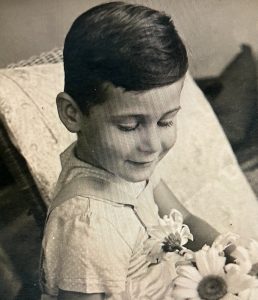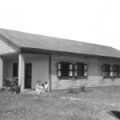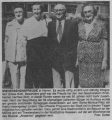- Local Survivor registry
- YORAM MEYER
- Local Survivor registry
- YORAM MEYER
Survivor Profile

YORAM
MEYER
(1943-PRESENT)
PRE-WAR NAME:
MEYER
MEYER
PLACE OF BIRTH:
PALESTINE, TEL AVIV
PALESTINE, TEL AVIV
DATE OF BIRTH:
NOVEMBER 11, 1943
NOVEMBER 11, 1943
LOCATION(s) BEFORE THE WAR:
NA
NA
LOCATION(s) DURING THE WAR:
PALESTINE, TEL AVIV
PALESTINE, TEL AVIV
STATUS:
CHILD REFUGEE
CHILD REFUGEE
RELATED PERSON(S):
ROBERTA MEYER - Spouse,
BERNHARD MEYER - Father (Deceased),
MARGARETE MEYER - Mother (Deceased),
DANIELA A. - SISTER ,
MAX MEYER (PATERNAL) - Grandfather (Deceased),
SELMA MOND (PATERNAL) - Grandmother (Deceased),
SALLY KIRCHHEIMER (MATERNAL) - Grandfather (Deceased),
HENRIETTA DIKHOFF (MATERNAL) - Grandmother (Deceased),
JEFF MEYER - Son
-
BRIEF BIOGRAPHY BY NANCY GORRELL
Yoram Meyer was born November 11, 1943 in Tel Aviv, Palestine. His parents, Bernhard and Margarete Meyer were both born in Germany, Bernhard from Unna and Margarete (Gretel) from Hamm. Yoram’s parents married in 1937 and due to the Nazi laws and oppression, fled Germany for Palestine. They lived in Palestine for 15 years where they raised their son Yoram and later his younger sister, Daniela born in 1950. In Tel Aviv, Yoram’s father drove a taxi for a living. In 1952, Yoram’s father felt compelled to leave the the State of Israel for economic reasons. Immigration to the United States was not possible due to quotas. Upon the urging of Margarete’s brother, Arturo Kircheimer who lived in Sosua in the Dominican Republic, Yoram’s family immigrated to Sosua. Initially, they lived in “el Batey,” but after a few weeks they moved to Bella Vista where they received a farm from the Dominican Republic Settlement Association (DORSA). Yoram’s parents managed to successfully run their Sosua farm. But in 1955, Yoram’s family moved once again to seek a better future. They arrived in Manhattan, New York, but did not stay long as they felt it was not a “good” place to raise young children. At the urging of a good friend, Inge Nierenberg that they knew from Germany and Palestine, they moved to Morristown, New Jersey where they permanently settled for the remainder of their lives. Bernhard worked in various merchandising roles until he finally bought a car rental franchise agency. Margarete worked as a teacher’s aide for special needs students. She resided in Morristown and lived an active life until her death at age 106. Yoram and his family reside in Morristown, New Jersey. Both Yoram and his son, Jeff, graduated from Morristown High School.
Refer to Related Media for historic photographs of Sosua, Dominican Republic and family photographs.
Refer to Survivor Registry for Inge Nierenberg.
-
SURVIVOR INTERVIEW:
Date: November 8, 2023
Location: SSBJCC Holocaust Memorial and Education Center Phone Interview
Interviewer: Nancy Gorrell
Q: Did your mother or father ever talk about growing up in Germany? Where did they come from? What was your ancestor’s hometowns?
A: Yes, they talked in general. Mother was from Hamm, Germany, and father was from Unna, Germany.
Q: Did your mother or father ever talk to you about the Holocaust?
A: Yes, they did talk about the Holocaust. I know one of my aunts died in Auschwitz and we think my paternal grandmother died there too. Actually, I believe that at Yad Vashem there are entrees for both of them. I never met any of any of my grandparents. My paternal grandparents died before I was born. On my mother’s side, they got out of Germany and went to Argentina because they already had some of their own children living there. At that time there were not many countries Jews could go to. I believe they left in Germany in 1941. It was very lucky they got out of Germany at that time. They stayed in Argentina after the war for the rest of their lives and are buried there.
Q: What are some of your childhood memories of Palestine? Where were you living in Tel Aviv? Did you have friends as a young child?
A: We lived in a three-story apartment building on the top floor. I remember roller skates and skating and there was a son of a friend of my mother’s that I played with.
Q: Do you remember any violence?
A: Yes. During the War for Independence, we had to go to the ground floor at night. There were no bomb shelters in our building. But there were sandbags in front of the exterior doors. I was about five or six.
Q: What did your father do for a living?
A: My father owned and drove a taxi. I remember he would come home and honk the horn. On some summer weekends, we took the taxi car and went to the beach.
Q: Why did your parents emigrate from Israel to the Dominican Republic?
A: The main reason was economic. But it was very complicated, and there were family reasons too. There was high inflation. It was difficult to make ends meet. My father would buy parts for his taxi car, and even if he didn’t use the parts, he knew he could sell them later. In 1952 when I was eight, my parents left Israel for the Dominican Republic.
Q: What are your memories of the Dominican Republic?
A: My uncle lived there and there were approximately 200 Jews there at the time as well. Then in 1955 my father decided to move to the United States, once again mainly for economic reasons. My parents also had friends and relatives in Washington Heights, New York, and so they went there first expecting to settle. But once they got to New York, my parents decided it was not a good place to raise kids. My mother knew Inge Nierenberg from Germany and Palestine. Inge was living at the time in Morristown, New Jersey. After a few months in Washington Heights, we moved to Morristown New Jersey where Inge and her spouse Jay lived.
Q: Did your family settle post-war in Morristown, New Jersey permanently?
A: Yes. I went to public school there, Alexander Hamilton, and then I graduated from Morristown High School.
-
HISTORICAL NOTES:
Evian-Les -Bains Conference (1938)
In March 1938, U.S. President Franklin Roosevelt convened a 32-nation conference at Evian-les-Bains, France, to discuss the resettlement of German and Austrian Jewish refugees to other lands. At that time, the Nazi regime was still agreeing to let Jews emigrate if they transferred their assets to the German government. The assembled nations endorsed the idea of resettlement but agreed that no nation would “be expected or asked to receive a greater number of emigrants than is permitted by existing legislation.” Given the xenophobic and anti-Semitic moods of the Depression era, this meant that, in effect, no nation – even the United States – was expected to take more than a few thousand refugees.
Dominican Republic and Trujillo
Only the Dominican Republic, led by dictator Rafael Trujillo, expressed a willingness to accept a significant number – between 50,000 and 100,000 Jews – an offer which the American Jewish Joint Distribution Committee (JDC) quickly accepted. Trujillo’s generosity probably stemmed mainly from his eagerness to have the Western nations overlook his brutal massacre of 25,000 Haitians in 1937 and his desire to “whiten” the people of his country, believing that the young European men would marry Dominican women and produce light-skinned offspring.
A powerful argument against spending millions to build Jewish colonies for a few thousand refugees was that the money could be better used to feed many tens of thousands of Jews then starving across Europe. Nonetheless, the JDC decided that the Dominican offer was too good to turn down, both on humanitarian grounds and because a Dominican resettlement project might provide a model for relocating Europe’s Jews after the war. (At this time, of course, there was little if any comprehension of the mass extermination the Nazis would unleash on European Jewry). The willingness to consider resettlement in Latin America also assumed that the British might never permit Palestine to become a Jewish homeland.
Dominican Republic Settlement Association (DORSA)
The Dominican government welcomed the Jews on the condition that they become agricultural workers rather than “commission agents.” The JCS created a special organization, the Dominican Republic Settlement Association (DORSA) and funded it to purchase 26,000 acres in the Dominican town of Sosua, which had previously been developed as a banana plantation but was abandoned by the United Fruit Company.
On January 30, 1940. DORSA officials signed a contract with the Trujillo regime. Historian Nicholas Ross, writing in the journal of the American Jewish Historical Society, quotes the contract:
The Republic … hereby guarantees to the settlers and their descendants, full opportunity to continue their lives and occupations free from molestation, discrimination or persecution, with full freedom of religion … civil, legal and economic rights, as well as other rights inherent to human beings.
The refugees were settled in the tiny seacoast town of Sosua, then just jungle land, which Trujillo had established with funding provided by the JDC. Upon arrival, every new Jewish settler was given 80 acres of land, 10 cows, a mule and a horse.
Despite this encouraging start, the Sosua experiment struggled. Submarine warfare in the Atlantic and the need to use Allied ships for troops and supplies made it possible to relocate only 50 or so refugees in the first year. Most of those who came initially were aged fifty or older, typical of German Jewry at this time. Some refugees wished to begin life again as Dominican farmers, but an equal number saw Sosua only as a place to wait until they could get a visa to enter the United States. It soon became clear that it would cost about $3,000 to settle a family on a tract of Sosua land and equip it for farming. The land was not highly fertile and its drainage poor. The settlers needed a period of adjustment to the semi-tropical climate of the island. Tomatoes, the first crop chosen for commercial exploitation, proved unattractive to the local Dominican population. The colony appeared headed for disintegration.
James N. Rosenberg, head of the Dominican Republic Settlement Association(DORSA), refused to let the experiment die:
Half the world lives now under the shadow of war, persecution, horror and death. … Now an open door of hope beckons. … We must carry this endeavor to accomplishment. … We dare not falter.
DORSA imported experts from kibbutzim in Palestine to teach the settlers communal agriculture. They helped design and build a communal meat processing plant and butter and cheese factory and recommended raising lemongrass for its oil, which is commercially used in perfume. A trickle of refugees continued into the town even though America’s entry into the war made it harder to cross the Atlantic.
In October 1941, the Nazis cut off Jewish emigration from the territories they occupied in Europe. Sosua’s Jewish population peaked at about 500. By this point, DORSA had invested about $1 million in the project.
By 1944, Sosua’s fortunes turned, DORSA abandoned communal agriculture and gave the settlers private plots. They focused on raising cattle and butter and cheese production and prospered. Still, most Jews left for the U.S. or Israel.
Today, about 25 Jewish families remain in Sosua. Their dairy business supplies most of the butter and cheese consumed in the Dominican Republic. Next to the town’s synagogue is a museum. The final caption on its exhibit reads:
Sosua, a community born of pain and nurtured in love must, in the final analysis, represent the ultimate triumph of life.
Retrieved Jewish Virtual Library November 10, 2023
https://www.jewishvirtuallibrary.org/dominican-republic
-
Sources and Credits:
Credits:
Holocaust Memorial and Education Center Interview with Yoram Meyer, (November 8, 2023); Brief Biography by Nancy Gorrell; Digital historic and family photographs donated by Yoram Meyer; History and photographs of Dominican Republic’s settlement of European Jewish refugees courtesy of Sosua Virtual Museum.
SSBJCC gratefully acknowledges the donation of historic and family digital photographs from Yoram Meyer as well as testimonial interview.







